
A rangefinder camera is a camera fitted with a rangefinder, typically a split-image rangefinder: a range-finding focusing mechanism allowing the photographer to measure the subject distance and take photographs that are in sharp focus.

Leica Camera AG is a German company that manufactures cameras, optical lenses, photographic lenses, binoculars, and rifle scopes. The company was founded by Ernst Leitz in 1869, in Wetzlar, Germany. The name Leica is derived from the first three letters of the founder's surname (Leitz) and the first two of the word camera: lei-ca.
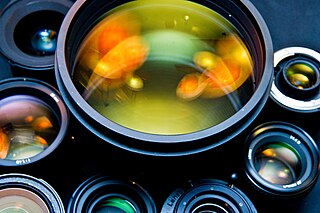
A camera lens is an optical lens or assembly of lenses used in conjunction with a camera body and mechanism to make images of objects either on photographic film or on other media capable of storing an image chemically or electronically.
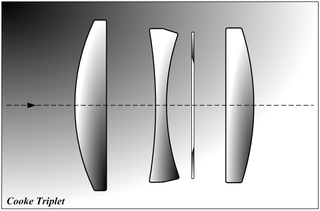
The Cooke triplet is a photographic lens designed and patented in 1893 by Dennis Taylor who was employed as chief engineer by T. Cooke & Sons of York. It was the first lens system that allowed the elimination of most of the optical distortion or aberration at the outer edge of the image.
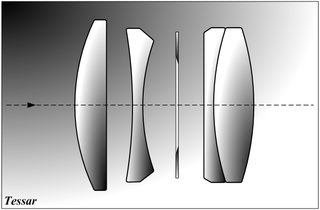
The Tessar is a photographic lens design conceived by the German physicist Dr. Paul Rudolph in 1902 while he worked at the Zeiss optical company and patented by Zeiss in Germany; the lens type is usually known as the ZeissTessar. Since its introduction, millions of Tessar and Tessar-derived lenses have been manufactured by Zeiss and other manufacturers, and are still produced as excellent intermediate aperture lenses.

A zoom lens is a system of camera lens elements for which the focal length can be varied, as opposed to a fixed-focal-length (FFL) lens.

Voigtländer was a significant long-established company within the optics and photographic industry, headquartered in Braunschweig, Germany, and today continues as a trademark for a range of photographic products.

In photography, a viewfinder is a device on a camera that a photographer uses to determine exactly where the camera is pointed, and approximately how much of that view will be photographed. A viewfinder can be mechanical, with simple optical components, with precision optics and optical functions, or a digital accessory device used with digital cameras.

The Sony Cyber-shot DSC-R1 is a bridge digital camera announced by Sony in 2005. It featured a 10.3 megapixel APS-C CMOS sensor, a size typically used in DSLRs and rarely used in bridge cameras. This was the first time such a large sensor was incorporated into a bridge camera. Besides the APS-C sensor, the DSC-R1 also featured a 14.3–71.5 mm Carl Zeiss Vario-Sonnar T* lens, providing for an angle of view equivalent to 24–120 mm on a full frame camera.

Image stabilization (IS) is a family of techniques that reduce blurring associated with the motion of a camera or other imaging device during exposure.
Kiron Corporation was a subsidiary of Kino Precision Industries, Ltd., a Japanese manufacturer of photographic lenses. Kiron was based in Carson, California, operating in the 1980s primarily as the United States distributor of Kiron lenses, which were offered in a variety of mounts compatible with many popular 135 film manual focus single-lens reflex camera systems. Kino Precision was founded in 1959 and by the time Kiron was organized in 1980, Kino Precision had gained experience manufacturing lenses sold by Vivitar, including several marketed under the latter company's premium "Series 1" line. After Kino Precision decided to market lenses directly, the Kiron name was adopted for the lenses and the distributor.

The Nikkorex nameplate was used for a series of 35 mm film, single-lens reflex cameras sold by Japanese optical manufacturer Nippon Kogaku K.K., as well as a series movie cameras and movie projectors. The models, made by other companies, were designed and marketed as low-cost, feature-reduced equipment for the consumer market.
A dialyte lens is a compound lens design that corrects optical aberrations where the lens elements are widely air-spaced. The design is used to save on the amount of glass used for specific elements or where elements can not be cemented because they have dissimilar curvatures. The word dialyte means "parted", "loose" or "separated" in Greek.
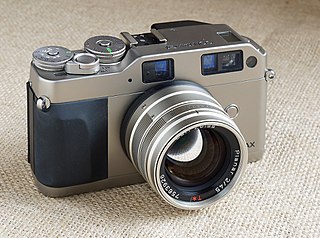
The Contax G camera line consists of two cameras, the G1 and G2, interchangeable-lens cameras sold by Kyocera under the Contax brand in competition with the Leica M7, Cosina Voigtländer Bessa-R, and Konica Hexar RF. The G1 was introduced in 1994 with the G2 joining it in 1996. In 2005, Kyocera retreated from the camera business and announced it would cease all activity related to the manufacture of Contax cameras at the end of the year, effectively spelling the end of the G system.

The Micro Four Thirds system is a standard released by Olympus Imaging Corporation and Panasonic in 2008, for the design and development of mirrorless interchangeable lens digital cameras, camcorders and lenses. Camera bodies are available from Blackmagic, DJI, JVC, Kodak, Olympus, OM System, Panasonic, Sharp, Logitech Mevo and Xiaomi. MFT lenses are produced by Cosina Voigtländer, Kowa, Kodak, Mitakon, Olympus, Panasonic, Samyang, Sharp, Sigma, SLR Magic, Tamron, Tokina, TTArtisan, Veydra, Xiaomi, Laowa, Yongnuo, Zonlai, Lensbaby, Venus Optics and 7artisans amongst others.
The design of photographic lenses for use in still or cine cameras is intended to produce a lens that yields the most acceptable rendition of the subject being photographed within a range of constraints that include cost, weight and materials. For many other optical devices such as telescopes, microscopes and theodolites where the visual image is observed but often not recorded the design can often be significantly simpler than is the case in a camera where every image is captured on film or image sensor and can be subject to detailed scrutiny at a later stage. Photographic lenses also include those used in enlargers and projectors.

The Panasonic Lumix DMC-GH1 is a digital mirrorless interchangeable lens camera adhering to the Olympus and Panasonic developed Micro Four Thirds System (MFT) system design standard. Panasonic classified the GH1 as a hybrid stills/video camera and the GH1 was introduced and marketed as a higher end camera than Panasonic's first MFT camera, the stills only, non-video capable Lumix DMC-G1.
The Panasonic Lumix Vario 14-140mm is a zoom lens for Micro Four Thirds system cameras; the first version, distinguished by its maximum aperture of f/4.0–5.8, served as the bundled kit lens for the Panasonic Lumix DMC-GH1, and later GH2; for other cameras, it was available for separate purchase. As the Panasonic GHn camera line are designed for both still photography and video, the lens has a fast, quiet autofocus motor and a stepless aperture diaphragm, hence the "HD" branding.

The invention of the camera in the early 19th century led to an array of lens designs intended for photography. The problems of photographic lens design, creating a lens for a task that would cover a large, flat image plane, were well known even before the invention of photography due to the development of lenses to work with the focal plane of the camera obscura.
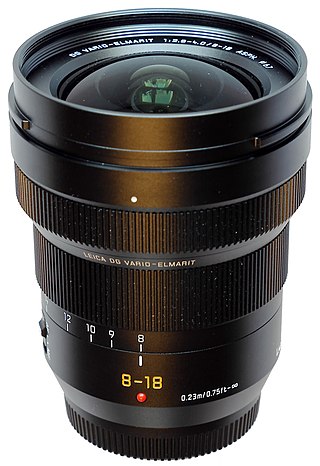
The Panasonic Leica DG Vario-Elmarit 8–18 mmf/2.8-f/4.0 lens is a digital compact ultra wide angle lens for Micro Four Thirds system cameras. It is a varifocal lens branded with the German label Leica, but manufactured by Panasonic in Japan.


















